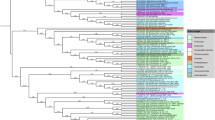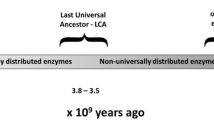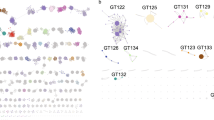Abstract
The ROK (repressor, open reading frame, kinase) protein family (Pfam 00480) is a large collection of bacterial polypeptides that includes sugar kinases, carbohydrate responsive transcriptional repressors, and many functionally uncharacterized gene products. ROK family sugar kinases phosphorylate a range of structurally distinct hexoses including the key carbon source d-glucose, various glucose epimers, and several acetylated hexosamines. The primary sequence elements responsible for carbohydrate recognition within different functional categories of ROK polypeptides are largely unknown due to a limited structural characterization of this protein family. In order to identify the structural bases for substrate discrimination in individual ROK proteins, and to better understand the evolutionary processes that led to the divergent evolution of function in this family, we constructed an inclusive alignment of 227 representative ROK polypeptides. Phylogenetic analyses and ancestral sequence reconstructions of the resulting tree reveal a discrete collection of active site residues that dictate substrate specificity. The results also suggest a series of mutational events within the carbohydrate-binding sites of ROK proteins that facilitated the expansion of substrate specificity within this family. This study provides new insight into the evolutionary relationship of ROK glucokinases and non-ROK glucokinases (Pfam 02685), revealing the primary sequence elements shared between these two protein families, which diverged from a common ancestor in ancient times.





Similar content being viewed by others
References
Abascal F, Zardoya R, Posada D (2005) ProtTest: selection of best-fit models of protein evolution. Bioinformatics 9:2104–2105
Altschul SF, Madden TL, Schäffer AA, Zhang J, Zhang Z, Miller W, Lipman DJ (1997) Gapped BLAST and PSI-BLAST: a new generation of protein database search programs. Nucleic Acids Res 17:3389–3402
Angell S, Schwarz E, Bibb MJ (1992) The glucose kinase gene of Streptomyces coelicolor A3(2): its nucleotide sequence, transcriptional analysis and role in glucose repression. Mol Microbiol 19:2833–2844
Eddy SR (1998) Profile hidden Markov models. Bioinformatics 9:755–763
Finn RD, Tate J, Mistry J, Coggill PC, Samut JS, Hotz HR, Ceric G, Forslund K, Eddy SR, Sonnhammer EL, Bateman A (2008) The Pfam protein families database. Nucleic Acids Res 36:D281–D288
Fischer E (1894) Einfluss der configuration auf die Wirkung der enzyme. Ber Dtsch Chem Ges 27:2984–2993
Greene GL (1969) Enzymes of glucose catabolism pathways in Colletotrichum and Gloeosporium. Mycologia 61:902–914
Hantke K (2001) Iron and metal regulation in bacteria. Curr Opin Microbiol 4:172–177
Holmes KC, Sander C, Valencia A (1993) A new ATP-binding fold in actin, hexokinase and Hsc70. Trends Cell Biol 2:53–59
Ito S, Fushinobu S, Yoshioka I, Koga S, Matsuzawa H, Wakagi T (2001) Structural basis for the ADP-specificity of a novel glucokinase from a hyperthermophilic archae. Structure 9:205–214
Katoh K, Kuma K, Toh H, Miyata T (2005) MAFFT version 5: improvement in accuracy of multiple sequence alignment. Nucleic Acids Res 33:511–518
Kawai S, Mukai T, Mori S, Mikami B, Murata K (2005) Hypothesis: structure, evolution, and ancestor of glucose kinases in the hexokinase family. J Biosci Bioeng 4:320–330
Koshland DE Jr (1958) Application of a theory of enzyme specificity to protein synthesis. Proc Natl Acad Sci USA 44:98–104
Krem MM, Di Cera E (2001) Molecular markers of serine protease evolution. EMBO J 20:3036–3045
Kreuzer P, Gärtner D, Allmansberger R, Hillen W (1989) Identification and sequence analysis of the Bacillus subtilis W23 xylR gene and xyl operator. J Bacteriol 7:3840–3845
Larion M, Moore LB, Thompson SM, Miller BG (2007) Divergent evolution of function in the ROK sugar kinase superfamily: role of enzyme loops in substrate specificity. Biochemistry 46:13564–13572
Lokman BC, van Santen P, Verdoes JC, Krüse J, Leer RJ, Posno M, Pouwels PH (1991) Organization and characterization of three genes involved in d-xylose catabolism in Lactobacillus pentosus. Mol Gen Genet 1–2:161–169
Lunin VV, Li Y, Schrag JD, Iannuzzi P, Cygler M, Matte A (2004) Crystal structure of Escherichia coli ATP-Dependent glucokinase and its complex with glucose. J Bacteriol 186:6915–6927
McGoldrick S, O’Sullivan SM, Sheehan D (2005) Glutathione transferase-like proteins encoded in genomes of yeasts and fungi: insights into evolution of a multifunctional protein superfamily. FEMS Microbiol Lett 242:1–12
Mesak LR, Mesak FM, Dahl MK (2004) Bacillus subtilis GlcK activity requires cysteines within a motif that discriminates microbial glucokinase into two lineages. BMC Microbiol 4:6
Miller BG, Raines RT (2004) Identifying latent enzyme activities: substrate ambiguity within modern bacterial sugar kinases. Biochemistry 43:6387–6392
Miller BG, Raines RT (2005) Reconstitution of a defunct glycolytic pathway via recruitment of ambiguous sugar kinases. Biochemistry 44:10776–10783
Mukai T, Kuwai S, Mori S, Mikami B, Murata K (2004) Crystal structure of bacterial inorganic polyphosphate/ATP-glucomannokinase. J Biol Chem 48:50591–50600
Notredame C, Higgins DG, Heringa J (2000) T-Coffee: a novel method for fast and accurate multiple sequence alignment. J Mol Biol 1:205–217
Pearson WR (1998) Empirical statistical estimates for sequence similarities searches. J Mol Biol 1:40–47
Price MN, Dehal PS, Arkin AP (2009) FastTree: computing large minimum evolution trees with profiles instead of a distance matrix. Mol Biol Evol 7:1641–1650
Pupko T, Pe’re I, Graur D, Hasegawa M, Friedman N (2002) A branch-and-bound algorithm for the inference of ancestral amino-acid sequences when the replacement rate varies among sites: application to the evolution of five gene families. Bioinformatics 18:1116–1123
Rambaut A (2007) http://tree.bio.ed.ac.uk/software/figtree/
Schiefner A, Gerber K, Seitz S, Welte W, Diederichs K, Boos W (2005) The crystal structure of Mlc, a global regulator of sugar metabolism in Escherichia coli. J Biol Chem 32:29073–29079
Sizemore C, Buchner E, Rygus T, Witke C, Götz F, Hillen W (1991) Organization, promoter analysis and transcriptional regulation of the Staphylococcus xylosus xylose utilization operon. Mol Gen Genet 3:277–284
Smith SW, Overbeek R, Woese CR, Gilbert W, Gillevet PM (1994) The genetic data environment an expandable GUI for multiple sequence alignment. Comput Appl Biosci 10:671–675
Stamatakis A (2006) RAxML-VL-HPC: ML-based phylogenetic analyses with thousands of taxa and mixed models. Bioinformatics 21:2688–2690
Titgemeyer F, Reizer J, Reizer A, Saier MH Jr (1994) Evolutionary relationships between sugar kinases and transcriptional repressors in bacteria. Microbiol 140:2349–2354
Wallace IM, O’Sullivan O, Higgins DG, Notredame C (2006) M-Coffee: combining multiple sequence alignment methods with T-Coffee. Nucleic Acids Res 34:1692–1699
Whelan S, Goldman N (2001) A general empirical model of protein evolution derived from multiple protein families using a maximum-likelihood approach. Mol Biol Evol 5:691–699
Acknowledgement
The authors wish to thank Adi Doron-Faigenboim and Tal Pupko for their technical assistance with the FastML program execution.
Author information
Authors and Affiliations
Corresponding authors
Electronic supplementary material
Below is the link to the electronic supplementary material.
239_2010_9351_MOESM6_ESM.fsa
Supplementary Figure 6: FASTA formatted ancestral node sequences resulting from phylogenetic analysis of the complete ROK data set. (FSA 333 kb)
Rights and permissions
About this article
Cite this article
Conejo, M.S., Thompson, S.M. & Miller, B.G. Evolutionary Bases of Carbohydrate Recognition and Substrate Discrimination in the ROK Protein Family. J Mol Evol 70, 545–556 (2010). https://doi.org/10.1007/s00239-010-9351-1
Received:
Accepted:
Published:
Issue Date:
DOI: https://doi.org/10.1007/s00239-010-9351-1




